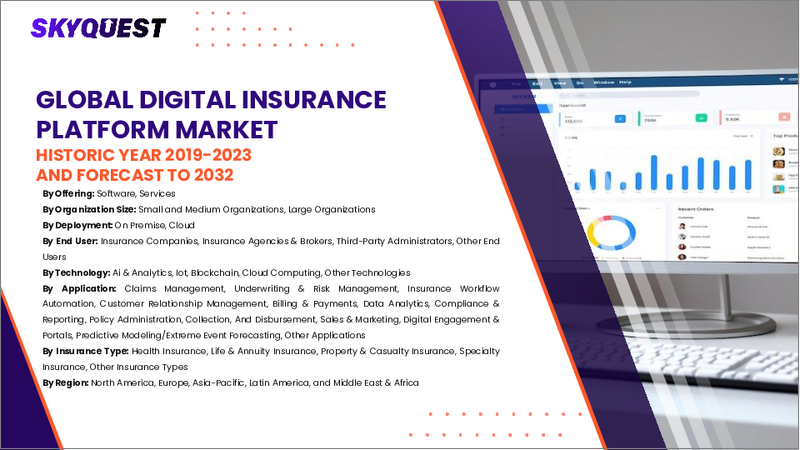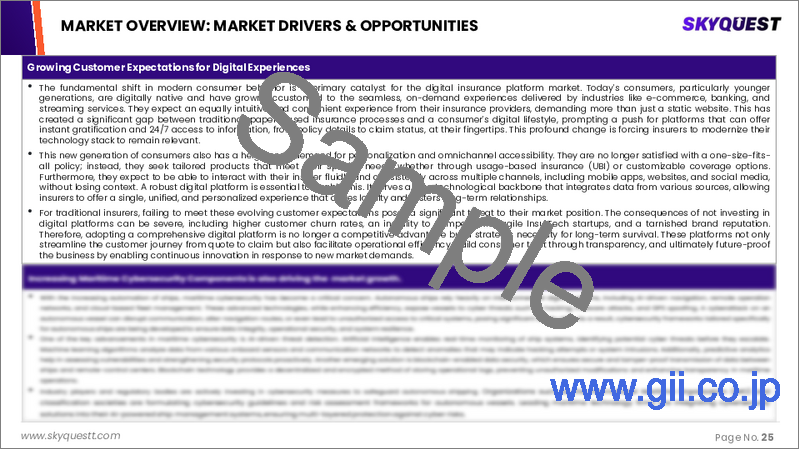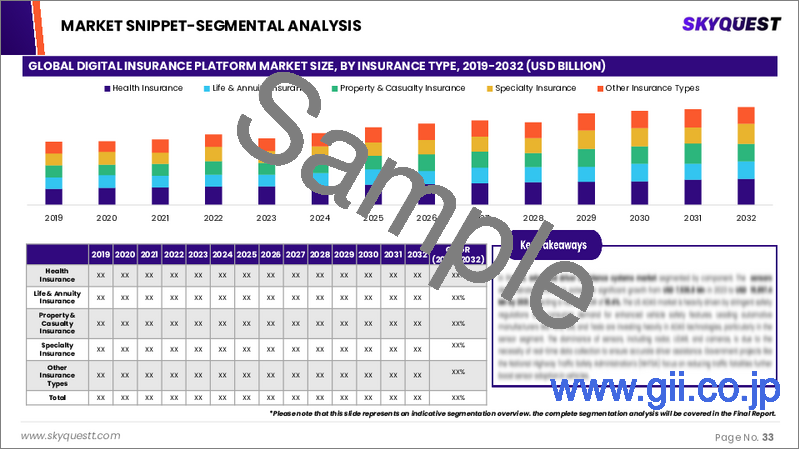|
|
市場調査レポート
商品コード
1724802
デジタル保険プラットフォームの市場規模、シェア、成長分析、コンポーネント別、用途別、組織規模別、展開タイプ別、エンドユーザー別、地域別 - 産業予測 2025~2032年Digital Insurance Platform Market Size, Share, and Growth Analysis, By Component (Solution, Service), By Application, By Organization Size, By Deployment Type, By End-User, By Region - Industry Forecast 2025-2032 |
||||||
|
|||||||
| デジタル保険プラットフォームの市場規模、シェア、成長分析、コンポーネント別、用途別、組織規模別、展開タイプ別、エンドユーザー別、地域別 - 産業予測 2025~2032年 |
|
出版日: 2025年05月09日
発行: SkyQuest
ページ情報: 英文 182 Pages
納期: 3~5営業日
|
全表示
- 概要
- 目次
デジタル保険プラットフォームの世界市場規模は2023年に1,352億米ドルとなり、予測期間(2025-2032年)のCAGRは11.6%で、2024年の1,508億8,000万米ドルから2032年には3,630億4,000万米ドルに成長する見通しです。
世界のデジタル保険プラットフォーム市場は、カスタマイズ可能でユーザーフレンドリーな保険ソリューションに対する需要の高まりにより、力強い成長を遂げています。顧客はオンデマンドサービスをますます求めるようになっており、保険会社はデジタル・プラットフォームを活用して顧客体験を向上させ、業務を合理化する必要に迫られています。インシュアテックの新興企業は、適応性の高い保険証券の作成を促進することで、この変革を推進する上で極めて重要な存在となっています。人工知能(AI)と機械学習(ML)の統合は、保険引受、不正防止、保険金請求処理に革命をもたらしています。主な市場促進要因としては、パーソナライズされた商品提供への要望、保険会社におけるデジタル導入の増加、規制環境の整備などが挙げられます。最近の動向は、利用ベースの保険、モバイルファースト商品、組み込み型保険の出現を強調しており、保険会社はより消費者中心のソリューションを提供する一方、レモネードとAXAとの提携に代表されるイノベーションと戦略的提携を通じて市場の成長を促進する立場にあります。
目次
イントロダクション
- 調査の目的
- 調査範囲
- 定義
調査手法
- 情報調達
- 二次と一次データの方法
- 市場規模予測
- 市場の前提条件と制限
エグゼクティブサマリー
- 世界市場の見通し
- 供給と需要の動向分析
- セグメント別機会分析
市場力学と見通し
- 市場概要
- 市場規模
- 市場力学
- 促進要因と機会
- 抑制要因と課題
- ポーターの分析
主な市場の考察
- 重要成功要因
- 競合の程度
- 主な投資機会
- 市場エコシステム
- 市場の魅力指数(2024年)
- PESTEL分析
- マクロ経済指標
- バリューチェーン分析
- 技術分析
- 規制分析
デジタル保険プラットフォーム市場規模:コンポーネント別& CAGR(2025-2032)
- 市場概要
- ソリューション
- サービス
- プロ
- 管理
デジタル保険プラットフォーム市場規模:用途別& CAGR(2025-2032)
- 市場概要
- 自動車輸送と物流
- 生活と健康
- 商業ビルと住宅ビル
- ビジネスとエンタープライズ
- 農業
- その他
デジタル保険プラットフォーム市場規模:組織規模別& CAGR(2025-2032)
- 市場概要
- 中小企業
- 大企業
デジタル保険プラットフォーム市場規模:展開タイプ別& CAGR(2025-2032)
- 市場概要
- オンプレミス
- クラウド
デジタル保険プラットフォーム市場規模:エンドユーザー別& CAGR(2025-2032)
- 市場概要
- サードパーティの管理者とブローカー
- 保険会社
- アグリゲーター
デジタル保険プラットフォーム市場規模:地域別& CAGR(2025-2032)
- 北米
- 米国
- カナダ
- 欧州
- ドイツ
- スペイン
- フランス
- 英国
- イタリア
- その他欧州地域
- アジア太平洋地域
- 中国
- インド
- 日本
- 韓国
- その他アジア太平洋地域
- ラテンアメリカ
- ブラジル
- その他ラテンアメリカ地域
- 中東・アフリカ
- GCC諸国
- 南アフリカ
- その他中東・アフリカ
競合情報
- 上位5社の比較
- 主要企業の市場ポジショニング(2024年)
- 主な市場企業が採用した戦略
- 最近の市場動向
- 企業の市場シェア分析(2024年)
- 主要企業の企業プロファイル
- 企業の詳細
- 製品ポートフォリオ分析
- 企業のセグメント別シェア分析
- 収益の前年比比較(2022-2024年)
主要企業プロファイル
- Accenture(Ireland)
- TCS(India)
- IBM(US)
- DXC Technology(US)
- Oracle(US)
- Microsoft(US)
- SAP(Germany)
- Cogitate Technology Solutions(US)
- Cognizant(US)
- Inzura(UK)
- Pegasystems(US)
- Fineos(Ireland)
- Infosys(India)
- Bolt Solutions(US)
- EIS Group(US)
- Appian(US)
- Internet Pipeline(US)
- eBaoTech(China)
結論と提言
Global Digital Insurance Platform Market size was valued at USD 135.2 billion in 2023 and is poised to grow from USD 150.88 billion in 2024 to USD 363.04 billion by 2032, growing at a CAGR of 11.6% during the forecast period (2025-2032).
The global digital insurance platform market is experiencing robust growth, driven by a rising demand for customizable and user-friendly insurance solutions. Customers increasingly seek on-demand services, prompting insurers to utilize digital platforms to enhance the customer experience and streamline operations. Insurtech startups are pivotal in driving this transformation by facilitating the creation of adaptive policies. The integration of artificial intelligence (AI) and machine learning (ML) is revolutionizing underwriting, fraud prevention, and claims processing. Key market drivers include the desire for personalized offerings, increased digital adoption among insurers, and supportive regulatory environments. Recent trends highlight the emergence of usage-based insurance, mobile-first products, and embedded insurance, positioning insurers to deliver more consumer-centric solutions while promoting market growth through innovation and strategic collaboration, exemplified by Lemonade's partnership with AXA.
Top-down and bottom-up approaches were used to estimate and validate the size of the Global Digital Insurance Platform market and to estimate the size of various other dependent submarkets. The research methodology used to estimate the market size includes the following details: The key players in the market were identified through secondary research, and their market shares in the respective regions were determined through primary and secondary research. This entire procedure includes the study of the annual and financial reports of the top market players and extensive interviews for key insights from industry leaders such as CEOs, VPs, directors, and marketing executives. All percentage shares split, and breakdowns were determined using secondary sources and verified through Primary sources. All possible parameters that affect the markets covered in this research study have been accounted for, viewed in extensive detail, verified through primary research, and analyzed to get the final quantitative and qualitative data.
Global Digital Insurance Platform Market Segments Analysis
Global Digital Insurance Platform Market is segmented by Component, Application, Organization Size, Deployment Type, End-User and region. Based on Component, the market is segmented into Solution and Service. Based on Application, the market is segmented into Automotive Transportation & Logistics, Life & Health, Commercial & Residential Buildings, Business & Enterprise, Agriculture and Others. Based on Organization Size, the market is segmented into Small and Medium-Sized Enterprises (SMEs), Large Enterprises. Based on Deployment Type, the market is segmented into On-Premises and Cloud. Based on End-User, the market is segmented into Third-Party Administrators & Brokers, Insurance Companies and Aggregators. Based on region, the market is segmented into North America, Europe, Asia Pacific, Latin America and Middle East & Africa.
Driver of the Global Digital Insurance Platform Market
One of the primary catalysts for growth in the Global Digital Insurance Platform market is the increasing demand for tailored insurance solutions. In today's world, consumers expect personalized experiences across various sectors such as retail, travel, and dining. To maintain a competitive edge, digital insurance platforms must innovate and provide offerings that cater to individual customer needs. By leveraging advanced analytics and data collection techniques, these platforms can effectively gather insights into customers' preferences and requirements. As a result, the ability to deliver customized insurance products is essential for capturing consumer interest and driving market expansion.
Restraints in the Global Digital Insurance Platform Market
The Global Digital Insurance Platform market faces significant challenges due to the high costs associated with infrastructure, technology implementation, and employee training. Many traditional insurers struggle to seamlessly integrate new digital products into their existing systems. A case in point is in 2024, when several mid-sized insurers in Europe reported delays in their digital transformation efforts, largely due to compatibility problems, which hindered their competitive edge against fully digital-native insurers. As a result, these financial burdens and integration hurdles present substantial restraints on the growth and adoption of digital insurance platforms across the market.
Market Trends of the Global Digital Insurance Platform Market
The Global Digital Insurance Platform market is experiencing a significant trend towards AI-powered claims processing and underwriting, significantly transforming the landscape of insurance services. By leveraging advanced artificial intelligence technologies, insurers can automate critical functions such as risk assessment, fraud detection, and claims payment, leading to enhanced operational efficiency. A notable example is Lemonade's AI-driven claims payment system, launched in January 2025, which drastically reduced payment times from days to mere minutes, setting a new industry benchmark. This shift towards automation and personalization not only improves customer experiences but also positions insurers to adapt more rapidly to changing market demands and consumer expectations.
Table of Contents
Introduction
- Objectives of the Study
- Scope of the Report
- Definitions
Research Methodology
- Information Procurement
- Secondary & Primary Data Methods
- Market Size Estimation
- Market Assumptions & Limitations
Executive Summary
- Global Market Outlook
- Supply & Demand Trend Analysis
- Segmental Opportunity Analysis
Market Dynamics & Outlook
- Market Overview
- Market Size
- Market Dynamics
- Drivers & Opportunities
- Restraints & Challenges
- Porters Analysis
- Competitive rivalry
- Threat of substitute
- Bargaining power of buyers
- Threat of new entrants
- Bargaining power of suppliers
Key Market Insights
- Key Success Factors
- Degree of Competition
- Top Investment Pockets
- Market Ecosystem
- Market Attractiveness Index, 2024
- PESTEL Analysis
- Macro-Economic Indicators
- Value Chain Analysis
- Technology Analysis
- Regulatory Analysis
Global Digital Insurance Platform Market Size by Component & CAGR (2025-2032)
- Market Overview
- Solution
- Service
- Professional
- Managed
Global Digital Insurance Platform Market Size by Application & CAGR (2025-2032)
- Market Overview
- Automotive Transportation & Logistics
- Life & Health
- Commercial & Residential Buildings
- Business & Enterprise
- Agriculture
- Others
Global Digital Insurance Platform Market Size by Organization Size & CAGR (2025-2032)
- Market Overview
- Small and Medium-Sized Enterprises (SMEs)
- Large Enterprises
Global Digital Insurance Platform Market Size by Deployment Type & CAGR (2025-2032)
- Market Overview
- On-Premises
- Cloud
Global Digital Insurance Platform Market Size by End-User & CAGR (2025-2032)
- Market Overview
- Third-Party Administrators & Brokers
- Insurance Companies
- Aggregators
Global Digital Insurance Platform Market Size & CAGR (2025-2032)
- North America (Component, Application, Organization Size, Deployment Type, End-User)
- US
- Canada
- Europe (Component, Application, Organization Size, Deployment Type, End-User)
- Germany
- Spain
- France
- UK
- Italy
- Rest of Europe
- Asia Pacific (Component, Application, Organization Size, Deployment Type, End-User)
- China
- India
- Japan
- South Korea
- Rest of Asia-Pacific
- Latin America (Component, Application, Organization Size, Deployment Type, End-User)
- Brazil
- Rest of Latin America
- Middle East & Africa (Component, Application, Organization Size, Deployment Type, End-User)
- GCC Countries
- South Africa
- Rest of Middle East & Africa
Competitive Intelligence
- Top 5 Player Comparison
- Market Positioning of Key Players, 2024
- Strategies Adopted by Key Market Players
- Recent Developments in the Market
- Company Market Share Analysis, 2024
- Company Profiles of All Key Players
- Company Details
- Product Portfolio Analysis
- Company's Segmental Share Analysis
- Revenue Y-O-Y Comparison (2022-2024)
Key Company Profiles
- Accenture (Ireland)
- Company Overview
- Business Segment Overview
- Financial Updates
- Key Developments
- TCS (India)
- Company Overview
- Business Segment Overview
- Financial Updates
- Key Developments
- IBM (US)
- Company Overview
- Business Segment Overview
- Financial Updates
- Key Developments
- DXC Technology (US)
- Company Overview
- Business Segment Overview
- Financial Updates
- Key Developments
- Oracle (US)
- Company Overview
- Business Segment Overview
- Financial Updates
- Key Developments
- Microsoft (US)
- Company Overview
- Business Segment Overview
- Financial Updates
- Key Developments
- SAP (Germany)
- Company Overview
- Business Segment Overview
- Financial Updates
- Key Developments
- Cogitate Technology Solutions (US)
- Company Overview
- Business Segment Overview
- Financial Updates
- Key Developments
- Cognizant (US)
- Company Overview
- Business Segment Overview
- Financial Updates
- Key Developments
- Inzura (UK)
- Company Overview
- Business Segment Overview
- Financial Updates
- Key Developments
- Pegasystems (US)
- Company Overview
- Business Segment Overview
- Financial Updates
- Key Developments
- Fineos (Ireland)
- Company Overview
- Business Segment Overview
- Financial Updates
- Key Developments
- Infosys (India)
- Company Overview
- Business Segment Overview
- Financial Updates
- Key Developments
- Bolt Solutions (US)
- Company Overview
- Business Segment Overview
- Financial Updates
- Key Developments
- EIS Group (US)
- Company Overview
- Business Segment Overview
- Financial Updates
- Key Developments
- Appian (US)
- Company Overview
- Business Segment Overview
- Financial Updates
- Key Developments
- Internet Pipeline (US)
- Company Overview
- Business Segment Overview
- Financial Updates
- Key Developments
- eBaoTech (China)
- Company Overview
- Business Segment Overview
- Financial Updates
- Key Developments





